



Checking coding completeness by mining discharge summaries Stefan Schulz, Thorsten Seddig, Susanne Hanser, Albrecht Zaiß, Philipp Daumke
Background Methods Results Conclusions
Background Methods Results Conclusions Undercoding of in-patient treatment episodes is a common problem in hospital information systems § Incompleteness of disease encoding (ICD10) in hospitals § main diagnosis coded § comorbidities (secondary diseases) often not coded § typical: multimorbid patient admitted for surgical intervention (hip replacement, lens implant, prostatectomy…) § Investigation: Does undercoding affect reimbursement given a DRG (diagnosis related group ) - related reimbursement system ? § Setting: § University Hospital of Freiburg (Germany) § Only very severe comorbidities have impact on DRG grouping in German DRG system
Background Methods Results Conclusions Undocumented diagnoses can be detected by mining the EPR § Hypothesis: drug (ingredient) names in the EHR for which there is no justifying ICD code point to undocumented diseases § Most trustworthy source of drug prescriptions: Discharge summary (in many departments no structured documentation of drug administration) § Focus on three diseases, known to be readily omitted 1. Diabetes mellitus , 2. Parkinson's disease , 3. Bronchial asthma and chronic obstructive pulmonary disease (COPD) .
Background Methods Results Conclusions
Background Methods Results Conclusions Rule base checks medical texts annotated by ICD codes for completeness § For each of 34,865 treatment episodes: § discharge summary § one or more ICD codes § 17,000 used for training, 17,865 for testing § Rule base for diabetes, Parkinson's and COPD: § Drug indications (in ICD) manually extracted from two databases (Rote Liste, MMI) and enriched by off-label use from the training corpus § Including brand names and ingredient names § Each rule encoded as a triple R = ( D , P , N ) with D = string characterizing a drug P = "positive list" of ICD codes for the diseases under scrutiny N = "negative list" of ICD codes for other indications § Exact string match
Background Methods Results Conclusions Documents with unjustified drug mentions are filtered Filter algorithm retrieves documents (cases) for which no justification for a drug name (ICD code in the HIS) is found: For each d = {diabetes, Parkinson's, COPD} For each document: For each drug name specific to d: If drug name matches text token in document: If no match between any discharge ICD code and any code in the negative or positive list for d: Return document (candidate for undercoding)
Background Methods Results Conclusions Estimation of Precision and Recall § Precision: text samples (n = 3 * 50) of the retrieved texts were analyzed by a domain expert § Recall: roughly estimation by set of documents already annotated with a ICD code of interest. For each d = {diabetes, Parkinson's, COPD} For each document: If annotated with ICD code from positive list: For each drug name specific to d: If drug name matches text token in document: If no match between any discharge ICD code and any code in the negative list for d: Return document § Recall estimator: 1 – (# docs returned / # docs with ICD code from pos. list)
Background Methods Results Conclusions
Background Methods Results Conclusions High rate of false positives for Parkinson's and COPD ¡ Diabetes Parkinson Asthma / COPD Summaries with relevant drug names 984 232 875 Summaries without justifying ICD annotations 201 65 172 Sample for expert rating 50 50 50 Yes 39 7 27 Code missing? No 11 43 23 (expert rating) Precision 79% 14% 45% Estimated number of undercoded episodes 158 9 77 Candidates for missing codes as returned by algorithm 1 and estimated precision after rating of 50 treatment episodes per disease.
Background Methods Results Conclusions Most false positives due to other indications not coded or not in rule base Diabetes drugs Parkinson drugs Asthma / COPD drugs Multi organ failure. Restless legs syndrome not coded Foreign body in lung. Hyperglycemia as side effect of Essential tremor not coded Pulmonary atresia combined with severe respiratory infection rhinitis and varicella. Patient participates in a clinical trial Huntington's chorea Acute myleoid leukaemia and fever. Unique insulin dose given to Acute seizure Lymph node tuberculosis. Oxis to mitigate steroid side effects be taken on demand. Patient with a glucose tolerance Richardson Olszewski syndrome Pneumonia after stem cell test. transplantation. Lab result for serum insulin Paranoid schizophrenia Salbutamol to decrease the mesurement. potassium level 18 months-old infant is resuscitated Hypokinetic rigid syndrome Lung cancer Analysis of false positives
Background Methods Results Conclusions Recall low for Diabetes and COPD ¡ Retrieved cases using filter + - Total Recall 783/1814 = 43% Diabetes 783 1031 1814 106/151 = 70% Parkinson 106 45 151 99/272 = 36% Asthma / COPD 99 173 272 Recall estimation based on correctly coded diagnoses (algorithm 2).
Background Methods Results Conclusions Most false negatives due to diseases not treated by drugs Asthma / Diabetes Parkinson COPD Rate Specific drug administration Disease not mentioned in summary 11 14 11 72% treatment without drug Specific drug administration administration mentioned in summary 1 2% Drug not listed in rule base 5 3 16% Disease treatment with Drug name typing variant not drug matched with rule base 2 4% administration Drug not correctly recognized 1 2 6% Analysis of false negatives
Background Methods Results Conclusions
Background Methods Results Conclusions Undercoding significant, but not relevant for hospital revenue; methods can be optimized § Of all treatment episodes under scrutiny, 2% were undercoded re diabetes mellitus, Parkinson's or COPD § Diseases deemed secondary or unrelated to the actual clinical problem tend to be omitted, given that that they have no impact for DRG grouping § Very severe comorbidities (with relevance for DRG grouping) are normally coded; no single case of DRG- relevant undercoding § Improvement of the method: context sensitivity, spelling correction, automation of rule base construction, searching for other text elements
Recommend
More recommend